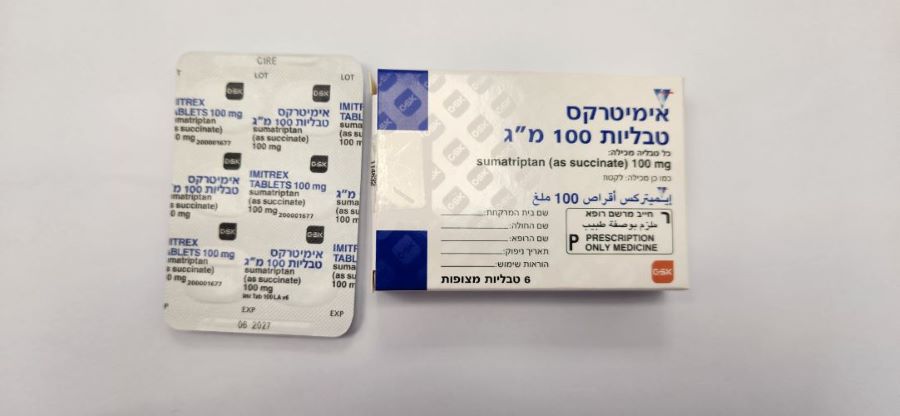Quest for the right Drug

אימיטרקס טבליות 100 מ"ג IMITREX TABLETS 100 MG (SUMATRIPTAN AS SUCCINATE)
תרופה במרשם
תרופה בסל
נרקוטיקה
ציטוטוקסיקה
צורת מתן:
פומי : PER OS
צורת מינון:
טבליות מצופות פילם : FILM COATED TABLETS
עלון לרופא
מינוניםPosology התוויות
Indications תופעות לוואי
Adverse reactions התוויות נגד
Contraindications אינטראקציות
Interactions מינון יתר
Overdose הריון/הנקה
Pregnancy & Lactation אוכלוסיות מיוחדות
Special populations תכונות פרמקולוגיות
Pharmacological properties מידע רוקחי
Pharmaceutical particulars אזהרת שימוש
Special Warning עלון לרופא
Physicians Leaflet
Special Warning : אזהרת שימוש
4.4 Special warnings and precautions for use Imitrex should only be used where there is a clear diagnosis of migraine. Sumatriptan is not indicated for use in the management of hemiplegic, basilar or ophthalmoplegic migraine. Before treating with sumatriptan care should be taken to exclude potentially serious neurological conditions (e.g. CVA, TIA) if the patient presents with atypical symptoms or if they have not received an appropriate diagnosis for sumatriptan use. Following administration, sumatriptan can be associated with transient symptoms including chest pain and tightness which may be intense and involve the throat (see section 4.8). Where such symptoms are thought to indicate ischaemic heart disease, no further doses of sumatriptan should be given and appropriate evaluation should be carried out. Sumatriptan should not be given to patients with risk factors for ischaemic heart disease, including those patients who are heavy smokers or users of nicotine substitution therapies, without prior cardiovascular evaluation (see section 4.3). Special consideration should be given to postmenopausal women and males over 40 with these risk factors. These evaluations however, may not identify every patient who has cardiac disease and, in very rare cases, serious cardiac events have occurred in patients without underlying cardiovascular disease. Sumatriptan should be administered with caution to patients with mild controlled hypertension since transient increases in blood pressure and peripheral vascular resistance have been observed in a small proportion of patients (see section 4.3). There have been rare post-marketing reports describing patients with serotonin syndrome (including altered mental status, autonomic instability and neuromuscular abnormalities) following the use of a selective serotonin reuptake inhibitor (SSRI) and sumatriptan. Serotonin syndrome has been reported following concomitant treatment with triptans and serotonin noradrenaline reuptake inhibitors (SNRIs) and triptan with tricyclic antidepressants (TCAs). If concomitant treatment with sumatriptan and an SSRI/SNRI is clinically warranted, appropriate observation of the patient is advised (see section 4.5). Sumatriptan should be administered with caution to patients with conditions which may affect significantly the absorption, metabolism or excretion of drugs, e.g. impaired hepatic (Child Pugh grade A or B; see section 5.2) or renal function (see section 5.2) . A 50mg dose should be considered in patients with hepatic impairment. Sumatriptan should be used with caution in patients with a history of seizures or other risk factors which lower the seizure threshold, as seizures have been reported in association with sumatriptan (see section 4.8). Patients with known hypersensitivity to sulphonamides may exhibit an allergic reaction following administration of sumatriptan. Reactions may range from cutaneous hypersensitivity to anaphylaxis. Evidence of cross-sensitivity is limited, however, caution should be exercised before using sumatriptan in these patients. Undesirable effects may be more common during concomitant use of triptans and herbal preparations containing St John’s Wort (Hypericum perforatum). Prolonged use of any type of painkiller for headaches can make them worse. If this situation is experienced or suspected, medical advice should be obtained and treatment should be discontinued. The diagnosis of medication overuse headache (MOH) should be suspected in patients who have frequent or daily headaches despite (or because of) the regular use of headache medications. Reports of transient and permanent blindness and significant partial vision loss have been reported with the use of 5-HT1 agonists. Since visual disorders may be part of a migraine attack, a causal relationship between these events and the use of 5-HT1 agonists has not been clearly established. Patients with rare hereditary problems of galactose intolerance, total lactase deficiency or glucose-galactose malabsorption should not take this medicine. This medicine contains less than 1 mmol sodium (23 mg) per tablet, that is to say essentially ‘sodium-free’.
Effects on Driving

שימוש לפי פנקס קופ''ח כללית 1994
Acute migraine attacks with or without aura, cluster headache (s.c. injection only). יירשם ע"י רופא נוירולוג לפי פרוטוקול טיפולי מחייב
תאריך הכללה מקורי בסל
01/01/1995
הגבלות
תרופה מוגבלת לרישום ע'י רופא מומחה או הגבלה אחרת
מידע נוסף
עלון מידע לצרכן
26.11.20 - עלון לצרכן אנגלית 26.11.20 - עלון לצרכן עברית 26.11.20 - עלון לצרכן ערבית 07.06.23 - עלון לצרכן אנגלית 07.06.23 - עלון לצרכן עברית 07.06.23 - עלון לצרכן ערבית 01.07.24 - עלון לצרכן עברית 20.08.24 - עלון לצרכן אנגלית 20.08.24 - עלון לצרכן עברית 20.08.24 - עלון לצרכן ערבית 29.07.14 - החמרה לעלון 04.06.20 - החמרה לעלון 19.07.20 - החמרה לעלון 26.11.20 - החמרה לעלון 03.07.24 - החמרה לעלוןלתרופה במאגר משרד הבריאות
אימיטרקס טבליות 100 מ"ג